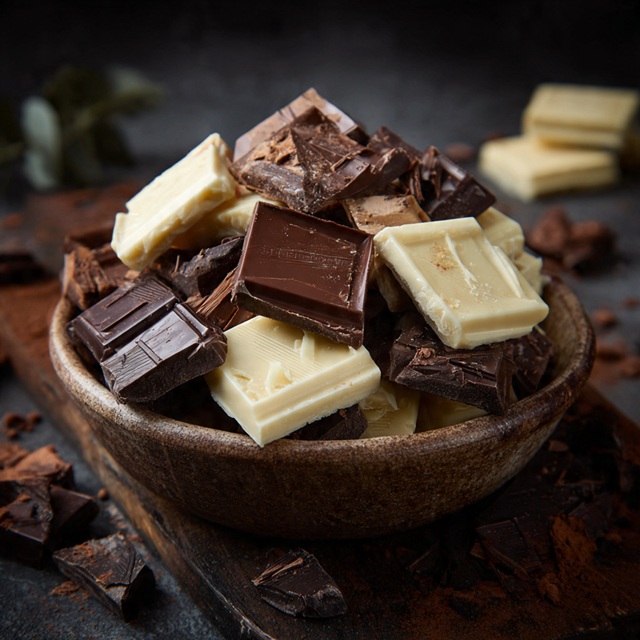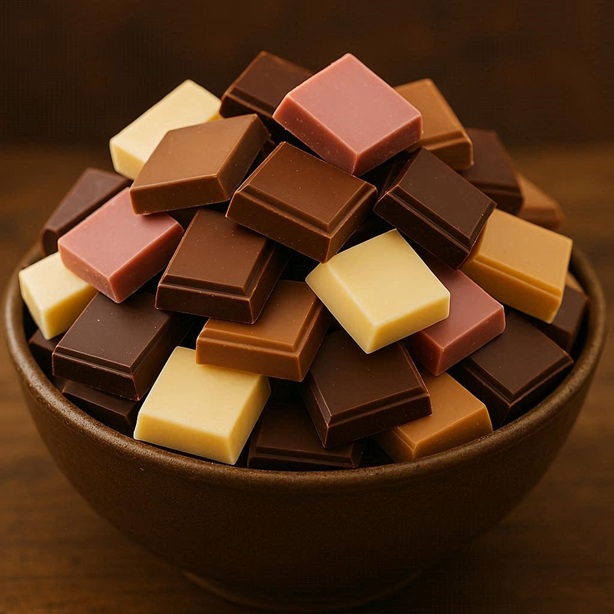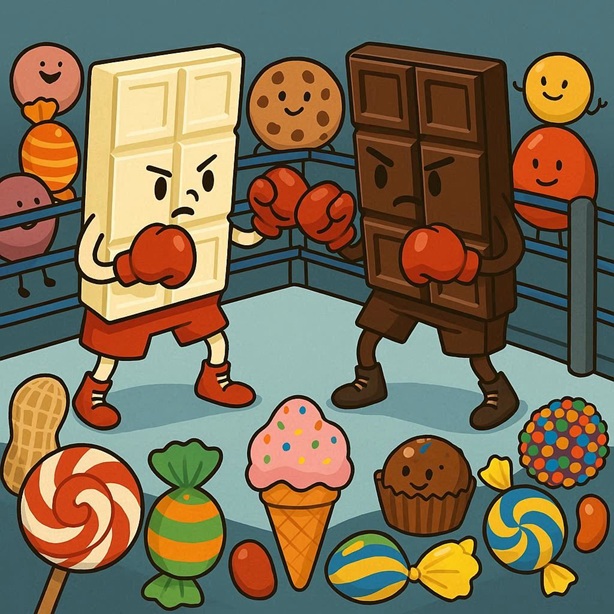Chocolate, the ultimate comfort food. We’ve all been there: devouring a whole bar in one sitting, hiding the evidence from our significant others, then pretending we’re surprised when those extra pounds magically appear. But have you ever stopped to think about what you’re really putting in your body? I mean, aside from the obvious sugar coma.
A friend of mine recently brought white chocolate to a party under the proud banner of “It’s healthier than dark chocolate!” That’s the kind of statement that makes nutritionists clutch their kale and chocolatiers break out in hives.

The Identity Crisis of White Chocolate
Let’s start by setting the record straight: white chocolate is made of cocoa butter, milk solids and sugar and maybe a few other things to make it taste less like a wax candle. Basically, the buttery fat from the cocoa bean is mixed with sweet dairy fluff. Think of it this way: cocoa solids are the soul of the bean. Without them, you’ve got a pale imposter. Cocoa butter gives white chocolate the technical right to be called “chocolate”, but let’s be honest, it’s more of a legal technicality than a flavor experience.
White chocolate has zero cocoa solids, the part of the cocoa bean that gives real chocolate its deep, complex flavor, brown color and mood-lifting bitterness. Without cocoa solids, white chocolate lacks caffeine and theobromine, the chemical duo responsible for chocolate’s mild stimulant effects. Theobromine, by the way, is a compound similar to caffeine, but a milder stimulant, often credited with chocolate’s mood-boosting properties, and the one reason your dog shouldn’t eat chocolate (but you probably should).
So, if you’re eating white chocolate, expecting a similar pick-me-up or a boost of antioxidants, you might as well be eating a stick of butter with sugar (which, to be fair, is not entirely inaccurate). So no, white chocolate isn’t healthier. It’s just sweeter, paler and less likely to keep you awake during a late-night Netflix binge.
Milk Chocolate: America’s Sweetheart
Milk chocolate isn’t just dark chocolate with a splash of dairy thrown in for good measure. It’s a different recipe entirely. Milk chocolate has less than 50% cocoa solids, often much less, with at least 12% milk solids and an enthusiastic heap of sugar. Lots and lots of sugar.
Sugar, of course, is America’s favorite nutritional tragedy. We love it more than we love our own common sense. From breakfast cereals to salad dressings, sugar sneaks into everything, like a toddler into a cookie jar. And milk chocolate? It’s basically sugar in a slightly more respectable outfit. It’s a thug, ready to take you out, but dressed to look good.
That doesn’t make milk chocolate evil, just more mainstream. Like reality television, it’s sweet, easy to take in and it rarely improves your intellect.
Dark Chocolate: The Thinking Person’s Candy
 For a chocolate to earn the proud label of “dark”, it needs to have more than 50% cocoa solids, usually up to 85% or more. Some sugar is added, of course, to cut down on the inherent bitterness and appeal to a broader palate, because, let’s be honest, pure cocoa mass will make your face pucker. The higher the cocoa percentage, the darker, richer and more bitter the chocolate gets and the more you can pretend you’re eating it “for your health”.
For a chocolate to earn the proud label of “dark”, it needs to have more than 50% cocoa solids, usually up to 85% or more. Some sugar is added, of course, to cut down on the inherent bitterness and appeal to a broader palate, because, let’s be honest, pure cocoa mass will make your face pucker. The higher the cocoa percentage, the darker, richer and more bitter the chocolate gets and the more you can pretend you’re eating it “for your health”.
Dark chocolate does offer legitimate benefits. It’s packed with antioxidants, flavonoids and compounds that can lower blood pressure and improve your mood, but before you start calling it a “superfood”, remember that it still contains fat and sugar. Eat it for joy, not for salvation.
Are There Other Types of Chocolate?
Indeed, there are! For the experimental crowd, there’s ruby chocolate, a naturally pink chocolate made from special ruby cocoa beans. It tastes fruity and tart, like someone mixed white chocolate with a raspberry. And there’s blond chocolate, also known as caramelized white chocolate. This one is pure genius. It’s essentially white chocolate that’s been slowly toasted until the sugars caramelize, giving it a rich, buttery, toffee-like flavor. It’s like white chocolate went to finishing school and learned some manners. Then there’s unsweetened baking chocolate, which exists mainly to humble the overconfident and cleanse the palate of anyone who mistakes it for a snack.
And if you see something labeled compound chocolate, that’s usually cocoa powder mixed with cheap vegetable fats instead of cocoa butter. It’s the budget cousin of chocolate, the one who borrows money and never calls back.

The “Healthy Chocolate” Myth: Fact or Fiction?
If you mean “can I eat a whole bag and suddenly have superpowers?”, then no. But when we talk about health benefits, we’re talking about dark chocolate, specifically chocolate with a high cocoa percentage (say, 70% or higher).
Dark chocolate has cocoa solids and they are packed with:
- Antioxidants: Flavonoids and polyphenols, which can help fight free radicals in your body. We’re talking more than some fruits here!
- Minerals: Iron, magnesium, copper, manganese, potassium, phosphorus, zinc and selenium.
- Fiber: A surprising amount of soluble fiber.
These components are linked to potential benefits like improved heart health, reduced inflammation and even mood enhancement.

And the active compounds in the cocoa solids are the true plaque fighters:
- Polyphenols, Tannins and Flavonoids: These are powerful antioxidants found in the cocoa bean. Research suggests they have an antibacterial effect in the mouth. They work by inhibiting the growth of the bacteria that cause plaque and by neutralizing the acids those bacteria produce when they break down sugar.
- Theobromine: This compound is also credited with having the potential to strengthen tooth enamel. Some studies suggest it may be as effective as fluoride in helping remineralization, making the enamel more decay-resistant.
- Low Sugar: High cocoa content dark chocolate has significantly less sugar than milk or white chocolate, which reduces the primary food source for the acid-producing bacteria in the first place.
But moderation is key. Eat one square, not one slab. As for white chocolate, well, it’s mostly fat and sugar, with fewer health benefits than a good sneeze.
So while some chocolate is better than others, “healthy chocolate” is about as mythical as guilt-free cheesecake.
My Personal Chocolate Manifesto
I have strong opinions about chocolate.
- White chocolate is the tofu of the candy world. It wants to be chocolate, but it’s missing the soul of the bean.
- Adding nuts to chocolate is a waste of chocolate. Just put the nuts in the trash and hand me the chocolate.
- Dark chocolate is my peace treaty. If you want me on your side, assure an uninterrupted supply of 80% or better dark chocolate. My loyalty is directly proportional to the cocoa content.
Closing Thoughts: Chocolate, Class and Cluelessness
In the world of chocolate, there are two kinds of people:
- Those who think Hershey’s Special Dark is “fancy”.
- And those who’ve tasted 90% cacao and thought, “Ah, this must be what enlightenment tastes like.”
Pedestrian chocolate is like store-brand wine. It’ll do in a pinch. But connoisseur chocolate? That’s an experience. It’s the difference between “I grabbed this at the gas station” and “I tasted this at a chocolatier in Brussels who spoke in percentages.”
Chocolate is like a relationship. It’s all about balance. Too sweet and it gets clingy, melts under pressure and leaves a gooey mess. Add just the right touch of darkness, though, and it’s dangerously irresistible. Because, let’s be honest, perfection is boring. A little edge makes it worth savoring.
So the next time someone tells you white chocolate is healthier, smile politely, offer them a piece of real dark chocolate and watch as their taste buds wake up to the truth.
Discover more from Tales of Many Things
Subscribe to get the latest posts sent to your email.
